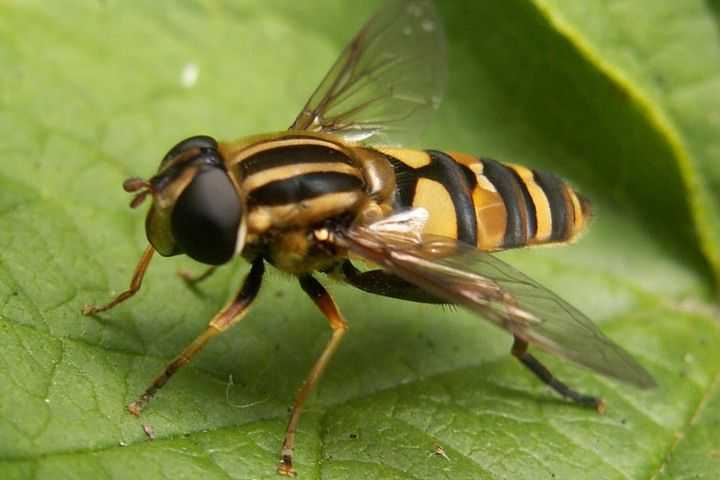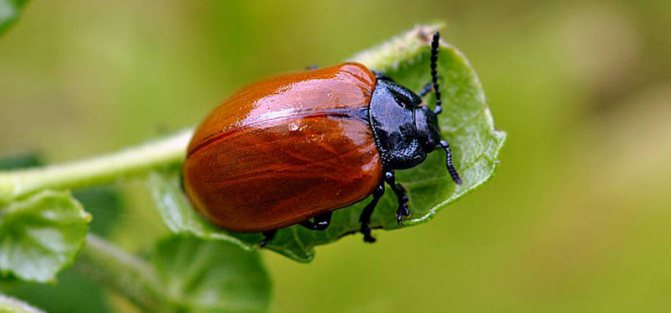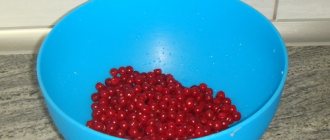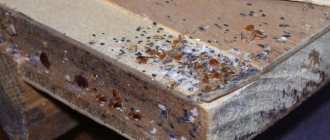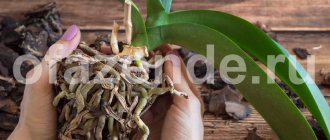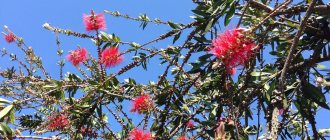Viburnum pests and methods of dealing with them
Viburnum leaf beetle
Leaf beetles can completely destroy planted viburnum bushes, and the fight against these pests is very difficult.
Many, most likely, had to experience this, so we will tell you about an effective method of dealing with leaf beetles.

Females gnaw the bark two millimeters deep, they can even hook on wood. Up to 25 light yellow eggs are laid in the hole. After the females close up the nest with bodily secretions, masking the color of the bark. But masonry can be distinguished by their convex shape. Some of them organize nests in the stalks of large racemes. As a result, the harvest drops sharply. By autumn, the beetles hibernate under the viburnum bush.
There is one fairly simple way to protect the viburnum from further harmful effects of leaf beetles. During the mass appearance of beetles in the middle of summer, they need to be shaken off early in the morning, at the moments of their least activity, from foliage to plastic wrap. Then put them in a bucket of water and pour away. Try to carry out this operation before the start of the procreation period.
We will also name proven folk remedies for pest control on viburnum. With the beginning of spring, when the branches of the viburnum have not yet overgrown with young leaves, you can cut off the tops of the shoots, where you can see the clutches of eggs. The cut pieces must be burned immediately. If everything is carefully checked and eliminated, then next year there will be no new bugs.
Viburnum leaf roll
This pest looks like a gray-blue or greenish-olive caterpillar with yellow sides and covered with light hairs. Its head is dark brown. Caterpillars hatched in spring devour buds when leaves are just beginning to emerge. They entangle them in cobwebs and knock them into lumps. By the middle of summer, the leafworm begins to pupate in the places of its feeding. In large quantities, this pest can almost completely devour the viburnum, which has a detrimental effect on the further harvest.
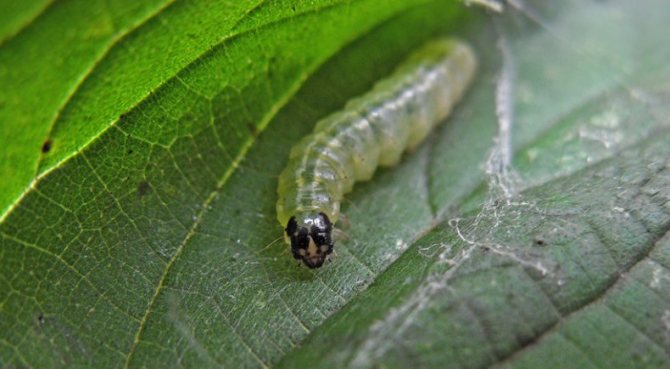

The fight against the leafworm is reduced to a simple collection of caterpillar nests and their subsequent burning. Before blooming buds, viburnum should be treated with Nitrafena paste. A 60% mixture comes out of a bucket of water with 250 grams of substance added to it. In the period from bud break to the appearance of buds, the shrub must be treated with a 10% solution of "Karbofos".
Viburnum and honeysuckle gall midges
Control measures for these pests consist in loosening the soil in early spring and late autumn. Before and after flowering, viburnum should be sprayed with a solution of "Karbofos" in a 10% ratio.
Green lobed moth
This pest is a yellow-green caterpillar with a brown line along the body and a similar color with specks. It damages only flowers, gnawing out their ovaries. To get rid of the lobed moth, the viburnum is sprayed with a 10% solution of Karbofos.
Honeysuckle prickly sawfly
The larva of this pest has an olive body with two rows of white transverse spines. The back is painted in burgundy or mesh pattern. The sides of the sawfly larva are light gray, and the head is yellow. They overwinter in the upper soil layers and pupate in the spring. Adults appear during the period of foliage blooming and can gnaw the viburnum naked.
The fight against sawflies begins in the fall with a thorough digging of the earth. Next, you should introduce preparations for viburnum: a 10% solution of "Karbofos" and wormwood broth, which are sprayed with viburnum before and after flowering.
Black viburnum aphid
Adult aphids on viburnum lay their eggs on the bark near the buds. The future larvae also hibernate there. Having been born, they make their way to the leaves and suck out all the nutrients from them. As a result, the leaves begin to curl, and the apical shoots deform.
At the beginning of summer, pests with wings appear, which colonize new plants. In August-September, the cycle closes - female black aphids produce the next offspring, which will overwinter.
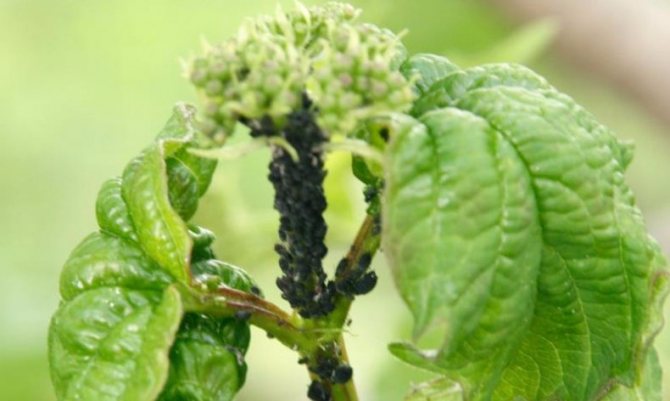

This pest is capable of migrating, but lives exclusively on viburnum. Hordes of black aphids damage young bushes with special efforts. The black viburnum aphid can migrate, but lives only on the viburnum. With particular cruelty, it damages young bushes. During the growing season of viburnum, aphids develop several generations.
Novice gardeners often wonder how to get rid of aphids on viburnum. To overcome the black viburnum aphid, you need to cut out and destroy the shoots that are common at the roots. There the pests lay eggs before hibernation. To destroy aphids, you can launch beneficial insects that feed on it. These can be hoverflies and larvae of lacewings, ladybugs.
Before bud break, treat the shoots with Nitrafen paste at a concentration of 60%. Herbal preparations help to get rid of aphids well: infusion of potato tops, pepper tincture or a solution of laundry soap.
Cap moth
The larch cap moth is a tiny butterfly with a wingspan of no more than 10 mm. Its gray body is covered with shiny scales. The moth larvae are not more than half a centimeter of orange-brown color. The caterpillar makes a shelter for itself in the form of a cover the size of a calf and hibernates there. In spring it feeds on viburnum leaves, pupates in June and becomes a butterfly in July, which lays a couple of eggs. Caterpillars hatch from eggs in summer.
In the fight against deciduous cap moth, the next spring treatment against pests will help - spraying the viburnum during the period of regrowth of young shoots. In the summer you need to use "Fufanon", "Aktellik", "Commander", "Iskra" and "Inta-vir".
Necessary prevention
Strawberry pests and control
For the prevention of viburnum diseases and to detect early signs of the appearance of pests, you need to regularly inspect the plant. If the leaves began to turn black, dry or rot, holes appeared on them, you need to look for the cause and fight it.
For prevention and treatment, it will not be superfluous to treat the bushes with onion, garlic or tobacco infusion, as well as soapy water (any of those described earlier) throughout the season. As a prevention of viburnum diseases, as well as for pest control, the use of insecticidal plants is perfect. It can be horse sorrel, dandelion, bitter wormwood.
It will not be possible to completely protect the viburnum, pests can attack again, but the timely detection and destruction of harmful insects will prevent them from laying eggs.
The main diseases of viburnum, treatment methods
The various diseases to which the calcine plant is susceptible can plague it year after year, and the number is astounding. The difficulty is that it is very difficult to find out the cause of the disease, even with a thorough diagnosis. One can only draw a single general conclusion that the plant has undergone a viral attack when spots or stripes appear on its leaves that differ from the natural color.
Read also: Review of the Universal-55 egg incubator
Powdery mildew
Leaf spot
On the leaves of the viburnum, gray spots of various shapes with a brown or purple border are formed. On the underside of the leaf, the spots are olive gray. By September, dark dotted fruiting bodies of the fungus begin to form on the dead tissue. Then the spots crack, dry, and the middle falls out of them.
Fighting spotting is easy enough. Remove all affected leaves from the shrub. During the budding period, it is necessary to spray Kalina with a Bordeaux mixture or copper oxychloride.
Gray and fruit rot
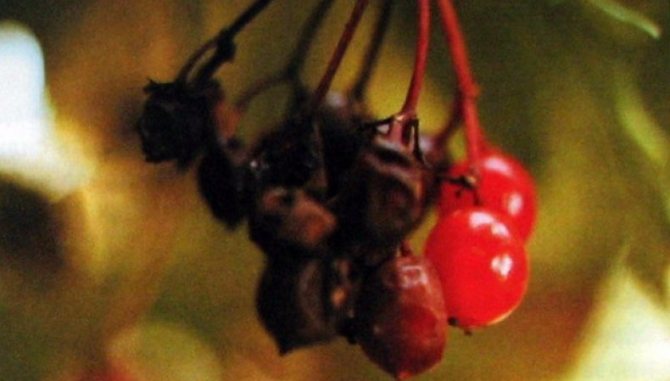

Fruit rot affects the young shoots of the plant. They dry up along with flowers, leaves and berries. With the onset of summer, the berries that were struck by the disease become covered with dense pads, then mummify and turn black.
You can cope with fruit rot by removing the mummified berries with the onset of autumn. You also need to spray the bushes with copper oxychloride before and after the flowering period of the viburnum.
Yellowing and mosaic leaves
To date, there are no known methods of combating this disease that would cope with it forever. The only thing that has been achieved is to find preventive measures and to develop varieties that are resistant to leaf mosaicism. If the level of infection has not reached a critical point, then diseased areas can be cut out. If the viburnum has suffered irreversible consequences, then the shrub must be dug up and burned.
Signs of infection are primarily visible on young, growing shoots. Light areas along the veins, yellow rings and star-shaped spots begin to be seen on them. Further, the spots turn white, and as they merge further, the leaf begins to turn yellow. Mosaic disease progresses faster at temperatures of 30 degrees, when the plant is heavily thickened.
Kalina leaf roll Description
The larvae of the viburnum leafworm are caterpillars of a grayish or greenish-olive color, which immediately after emergence in the spring begin to actively eat the buds and young leaves of the viburnum.


At the same time, they entangle the leaves with cobwebs, knocking them into a ball. Caterpillars pupate in the middle of summer.
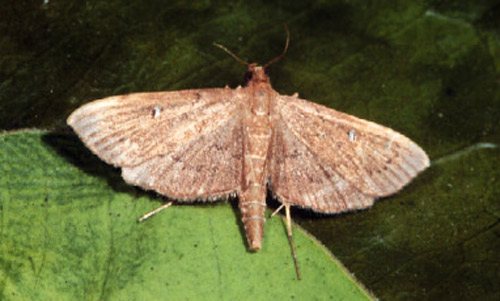

If conditions are favorable, they are able to gnaw out large areas of foliage in a short time, which negatively affects the yield.
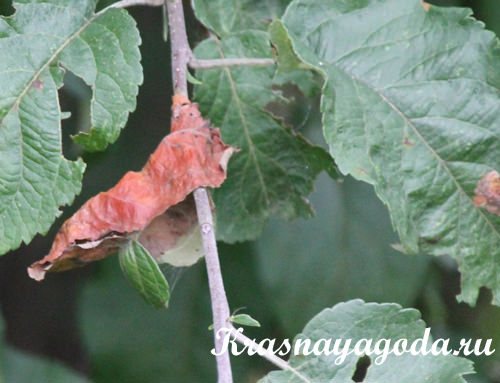

How to deal with the viburnum leaf roll
- Mechanical collection of nests together with pests and their subsequent burning will help to get rid of caterpillars.
- Also, before budding, it is recommended to treat the viburnum bush with nitrafen paste, and after budding - with karbofos.
- During the period of the mass appearance of insects, it is necessary to apply 0.05% inta-vir or decis (dissolve 1 tablet in 10 liters of water). After two weeks, the procedure is repeated.
How to treat viburnum from pests and aphids?
Viburnum, so named for the color of the berries - fiery red, like hot iron - grows in almost every summer cottage. Unfortunately, in every garden, it is also attacked by insects that can deprive the bushes of vitality in a short time. What, how and in what time frame it is necessary to process viburnum from aphids in order to prevent pests from actively multiplying is a topic that excites summer residents.
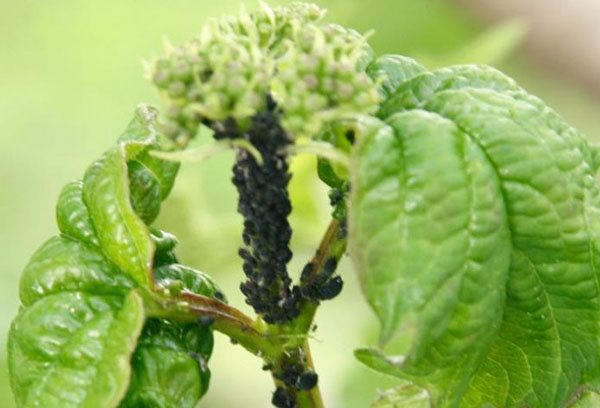

Preventive actions
To prevent the appearance of aphids on the viburnum, it is necessary every spring to clean the bush from the old flaking bark, under which there may be masonry, and whitewash the trunk with lime. You should also regularly cut out root growth and tops.
How to deal with a mole in the garden with folk remedies?
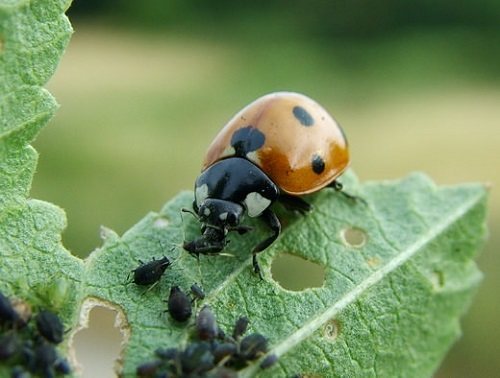

If there are ants in the garden that contribute to the development of aphids, it is necessary to get rid of them by spilling the places of accumulation with boiling water. But some insects, such as ladybugs, should, on the contrary, be attracted to the garden, since they eat aphids.
Black aphid
As soon as the first buds bloom on the viburnum, the black (viburnum) aphid occupies the young shoots.Deprived of vital juices, young leaves are deformed, curled. Dark spots of various shapes appear on them, which leads to complete drying and death of young twigs. In one season, several generations of aphids appear, and the first is equipped with wings - it has the ability to move from bush to bush, capturing all the plants, not only viburnum.
The last generation hibernates at the base of the bush and at the first signs of the beginning of spring rushes up the trunks, getting closer to the buds beginning to swell. That is why an active fight against the pest begins in early spring.
Viburnum aphid damages the entire site, but the main habitat is viburnum bushes. All the main means of struggle are used on them.
There are two main stages in the fight against black aphids.
- Creation of the most unfavorable conditions for laying eggs of the last, wintering generation. To do this, without regret, you have to cut out all the basal shoots, which abound in viburnum bushes. It is optimal to carry out such a thinning of the base of the bushes from the second half of summer.
- Spring treatment of bushes from a pest using chemicals or folk remedies.
In the first days of spring, before applying any remedies for the pest, the trunks of the viburnum bushes are cleaned of exfoliated old bark - most pests hibernate under it. After all the debris has been removed, hot water is poured over the ground under the bush.
The use of pesticides
The first treatment is carried out as soon as the spring sun warms up. During this period, the pests come out of hibernation and begin to move to the kidneys. The most effective drugs include:
All of them contain either neonicotinoids or phosphorus organics. They are also applicable in the fight against other pests of viburnum - sawflies, gall midges, viburnum leaf beetle. Prepare working solutions according to the manufacturer's instructions.
It is necessary to spray viburnum from pests in dry, calm weather with the use of personal protective equipment.
Good results are obtained by treating the viburnum with a solution of "Nitrafen" at the rate of 200 g of the product per 10 liters of water. The drug also needs to be sprayed on the dwellings of aphids - carriers of aphids.
Poisoning pests with chemicals is permissible only in early spring, since later periods of application will harm pollinating insects, especially bees.
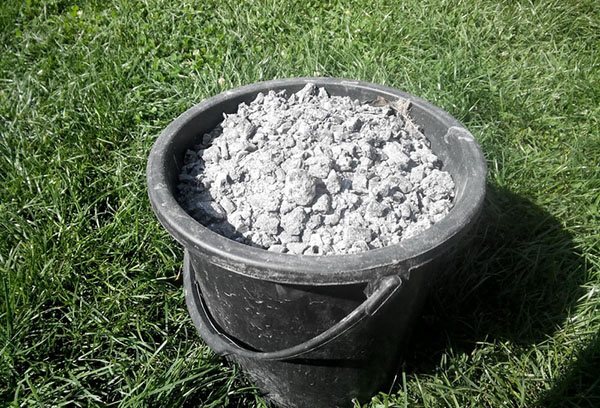

Folk remedies
The fact that folk remedies are less effective in the fight against aphids is a fairly common misconception. Their effectiveness is not lower than industrial pesticides, if they are prepared and applied according to all the rules. At the same time, solutions prepared according to "grandmother's" recipes can be used throughout the entire growing season. But it is better not to wait until the pest settles firmly on the viburnum, but to spray the affected plants immediately after the pest is detected.
Prepared from laundry or green soap - 300 g per bucket of water. Processing is carried out 2-3 times a week, after washing the bush with water from a hose under moderate pressure. Instead of soap, you can use some of the most inexpensive laundry detergents.
A glass of ash is brewed with a liter of boiling water, insisted for a day. Then add 40-50 g of soap or washing powder, bring the volume to 10 liters. Viburnum is sprayed once a week.
A solution is prepared from 20 ml of alcohol and a bucket of water. Viburnum is treated for pests twice, less often - three times, the interval between spraying is 2 weeks.
250 g of tobacco or makhorka is infused in 5 liters of water for 2 days. Then they filter, add 5 liters of water and process the bushes.
Take 1 kg of dry flowers on a bucket of hot water, insist for 12 hours. Filter the infusion, add 2 parts of water to 1 part of the infusion. Plants are treated with the finished solution immediately after mixing.
- Feverfew (Caucasian chamomile)
300 g of crushed dried flowers are poured with a small amount of boiling water, insisted for 2 hours, filtered, water is added up to 10 liters and the viburnum is immediately sprayed - the grass successfully fights against many pests of horticultural crops.
Read also: Growing gumi in the country
Dried pyrethrum flowers can be purchased at drugstores or garden stores under the trade name Persian Powder. The manufacturer indicates the recommendations for use on the packaging.
Pine or spruce needles are crushed and steamed with boiling water at the rate of 200 g of dry raw materials per liter of water. The infusion is kept tightly sealed for two days, after which it is sprayed with the affected bushes.
If there are thickets of this plant nearby, take young rosette leaves (about 200-300 g), pour a bucket of hot water and leave for 13 hours. Before spraying, add 30-50 g of liquid soap to the infusion.
Black henbane is a poisonous plant; care should be taken when working with it.
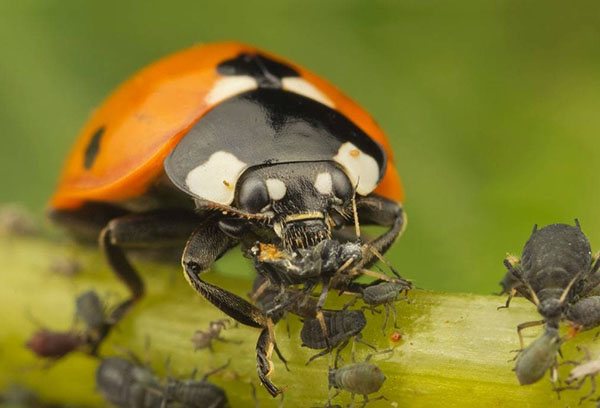

Biological methods of control
The use of deterrent factors and the attraction of natural enemies of aphids is of great help in the fight against the pest.
- To scare away, one- and perennial plants are planted next to the viburnum bushes, whose aroma of aphids cannot stand: lavender, marigolds, coriander, onions, etc.
- Ladybugs and other aphid-eating insects are attracted by sowing dill or leaf celery under viburnum.
- To lure small birds (tits, warblers, linnet), feeders, drinkers, nesting houses are equipped for them.
If attracting natural enemies of aphids to the site is one of the components of pest control, they use pesticides extremely carefully.
In the fight against aphids in the spring, all means are good. Their competent and timely use will save a beautiful bush with useful berries from pests and get a good harvest.
Folk recipes
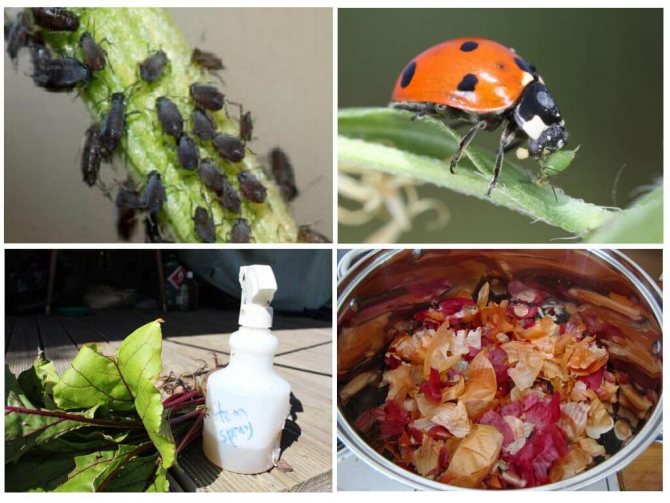

Folk remedies for aphids
The fight against aphids on viburnum is carried out in all known ways. Folk remedies are very diverse and unique, they make it possible to do without chemistry.
- To save the viburnum, to overcome thoroughly black aphids, it is necessary to cut out the shoots that are located at the roots in late autumn. It is in this place that the aphid lays eggs, leaves to winter. In the spring, when the shrub begins to bloom, pour hot water over the ground at the root.
- Natural enemies of insects are capable of destroying aphids - ladybugs, lacewing larvae, hoverflies.
- Viburnum can be sprayed with a solution of onion peel. Pests do not tolerate this smell, they try to hide from it faster. 200 g of husks are combined with 500 g of wood ash, 200 g of tobacco powder. Pour 10 liters of water. Leave to infuse for 5 days. Laundry soap is added before use, the finished product is filtered. It is necessary to spray viburnum in May even before the first leaves bloom, or during the flowering period. Repeat the procedure every week until the pests are gone.
- Wood ash is added to the water, spices - cinnamon, red, black pepper, soapy water. Pour the mixture into a spray bottle or spray bottle. The first time you need to spray the viburnum in the spring, then you should do this every month with a break of 7-14 reaps.
- You can get rid of aphids with a strong tincture of garlic, tobacco, pine needles. Their joint use and separately is allowed. 200 g of raw materials are poured into 1 liter of water, boiled for half an hour. Cover with a lid, leave for 5 days. Filter the finished product, add soap. Spraying is carried out.
- Grind potato tops, tomato or marigolds. Pour 10 liters of water, boil for half an hour. Insist at least a day. Viburnum is sprayed every 3 days during an active struggle. For prophylaxis, once every 2 weeks. It is allowed to prepare the product in reserve. The longer it costs, the greater the concentration of active ingredients.
On a note!
Aphids on Kalina buldenezh are exterminated by the same means. It is an ornamental shrub 3 m high with beautiful white flower buds that adorn the shrub in May.
Also used for aphids:
- ammonia;
- soda;
- milk and iodine;
- vinegar;
- celandine;
- mustard;
- vodka;
- green soap;
- Birch tar;
- boric acid.
Features of growing various varieties of viburnum
On the Crimean South Coast, viburnum blooms very early - starting from mid-December, but the peak of pink and snow-white flowering occurs in May.There are many varieties of viburnum and each has its own cultivation feature:
1. Kalina "avabuki"... This stately viburnum variety was bred in Japan as well as in South Korea. Avabuki belongs to the winter-hardy varieties of viburnum. At high temperatures, only foliage is damaged. On the southern shores of Crimea, during very cold winters, the tips of young shoots can freeze;
2. Barkwood... Propagated by cuttings, this variety of viburnum needs shading and drained soil;
3. Bodyian viburnum... Cutting propagation. Viburnum prefers a lot of sun, and also needs loosened and well-moisturized soil;
4. Gordovina... The homeland of this variety is Europe, North Africa and Southwest Asia. This variety has high frost resistance, perfectly tolerates temperatures down to -35C. The plant perfectly adapts to various conditions, both drought and high humidity:
5. David... This variety of viburnum is also propagated by cuttings. The plant prefers shady places with moist soil with good fertility;
6. Viburnum fragrant... Possesses weak frost resistance, tolerates only up to -5C. Propagated by cuttings. You need to plant in putrid, acidic, fertile soil;
7. Kalina Karlsa... This variety is widely used in Europe as a garden decoration, very hardy (-30C). The plant is not picky about lighting, it is necessary to plant it on drained soil;
8. Cinnamon-leaved viburnum... The variety was bred in China, where it is highly popular. The plant does not withstand low temperatures (up to -5C), it must be planted in acidic soil.
In order for the viburnum planting and care to be correct, the article contains photos.
Means used
In order to help the culture in the fight against dangerous ailments and pests, gardeners use a wide range of different compounds. They can be conventionally divided into several categories.
Folk
Means for the treatment and destruction of insect pests can be made from various components present in human everyday life. Among the most effective, it is worth noting:
- liquid formulations based on laundry or tar soap;
- decoctions of potato tops;
- pepper infusion;
- infusion of celandine.
The above means will be able to cure the viburnum from powdery mildew. To prepare a decoction of potato leaves, you will need at least a kilogram of green mass, which is poured with 10 liters of water, insisted. To prepare pepper tincture, a kilogram of pods is used, which are infused in 10 liters of water. To fight the disease with celandine, you need 3-4 kilograms of plants - they are crushed and insisted in a bucket of water.
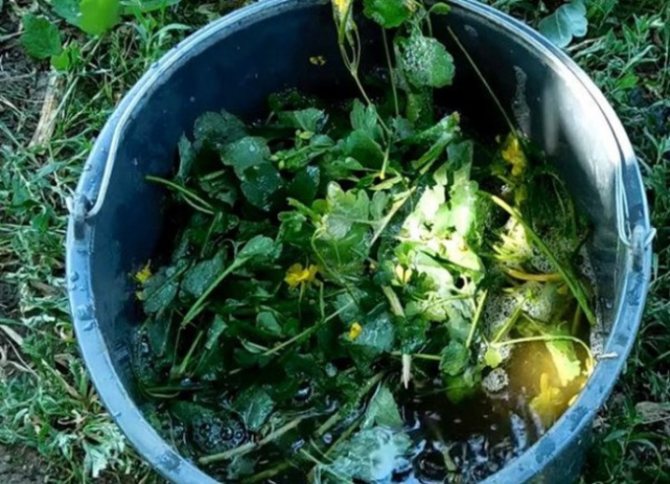

Ready-made compounds will need to process the entire aerial part of the viburnum. For effective action, re-spraying is carried out after a week.
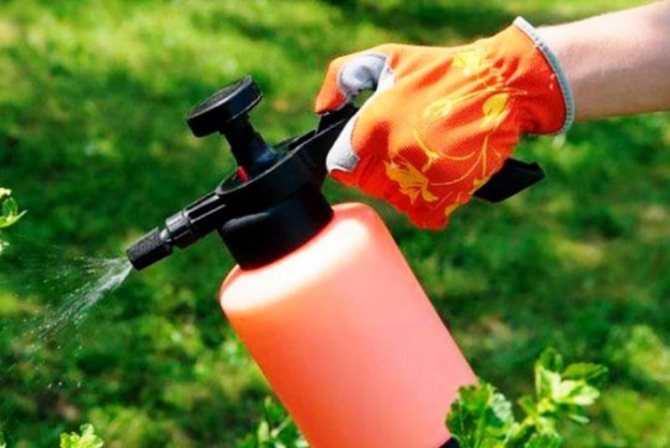

For the treatment of powdery mildew, you can prepare a copper-soap solution with the addition of ash. After the remedy has been infused for about 3 days, it is recommended to spray the viburnum once every 2 weeks.
To cure viburnum from spotting and rot using folk methods, it is recommended to use an infusion of tomato tops, for the preparation of which you will need 4 kilograms of green mass and a bucket of purified water.
Treatment with a decoction of chamomile also demonstrates effectiveness. You can use fresh or dried crops. In the first case, for 10 liters of water, at least 3 kilograms of culture will be required, dry chamomile should be used about 1 kilogram.
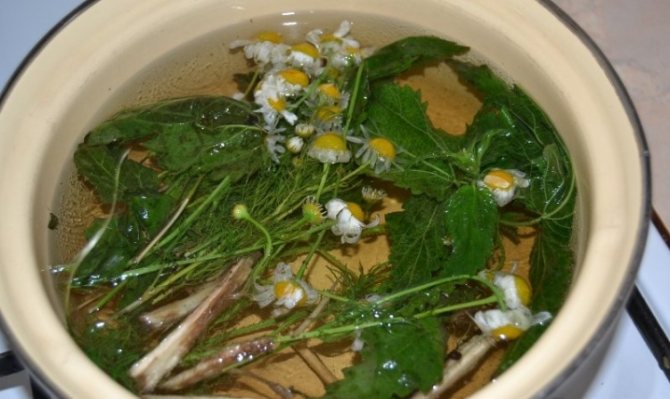

For the treatment of viburnum, in addition to soap solution, you can use soap with the addition of soda. As a rule, to treat a plant from gray or fruit rot, use half a bar of soap in a bucket of water and 1 spoonful of soda for each liter of liquid.
A liquid ash-based composition will help get rid of most viburnum pests. If you spray a tree with a solution, you can destroy pests without much difficulty, since, when it gets on the skin of an insect, the agent acts as a strong irritant. To consolidate the result obtained, you can combine the treatment with the treatment of the plant with soapy water.
To prepare the composition, you will need to take at least 300 grams of wood ash per garden bucket of water.


Another universal folk remedy for most pests will be a tobacco solution for treating viburnum. To make it, you need a bucket of water, about 200-250 grams of dried tobacco leaves, as well as a couple of hot pepper pods. For in order for the liquid to become suitable for processing, it must be allowed to infuse for at least 24 hours.
To get rid of the honeysuckle prickly sawfly, the gardener is recommended to use wormwood decoction, garlic or onion decoction for spraying. To prepare a composition based on wormwood, about 700-800 grams of dry grass is used for one bucket of water. A garlic remedy can be made from chopped slices, for onion broth you need a husk.


Chemicals
If the use of alternative methods has not brought results, and the viburnum continues to hurt, you can purchase specialized store products of a wide or narrow spectrum of action. You can treat a culture from powdery mildew with the following drugs:
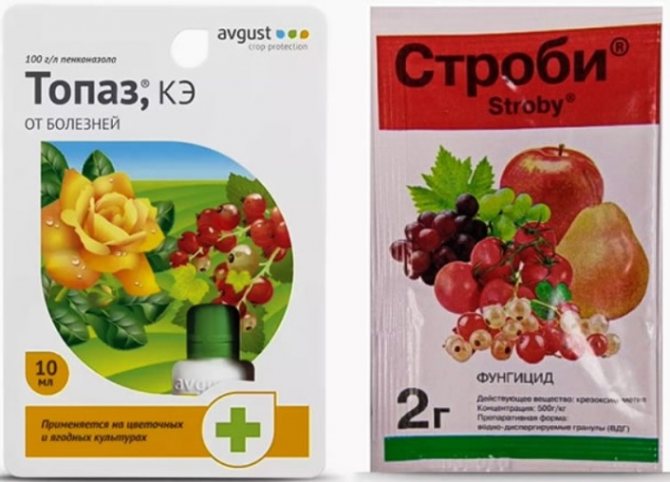

The spotting on the leaves of the viburnum can be overcome if the culture is sprayed with copper oxychloride or Bordeaux liquid. Bacterial spotting is successfully treated with "Abiga-Peak" or "Hom" preparations.
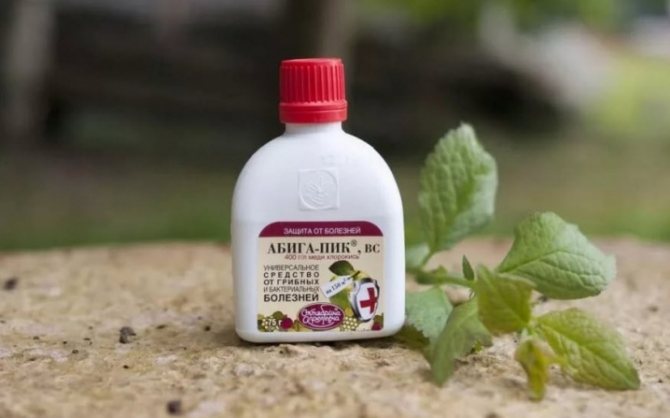

There are specialized chemicals that can help cure gray mold crops. Even at an advanced stage of the disease, it will be possible to help the culture if treated with the Vectra composition.
Insect pests are another problem besides disease. The fight against them is also actively carried out by the following store-bought chemical compositions:
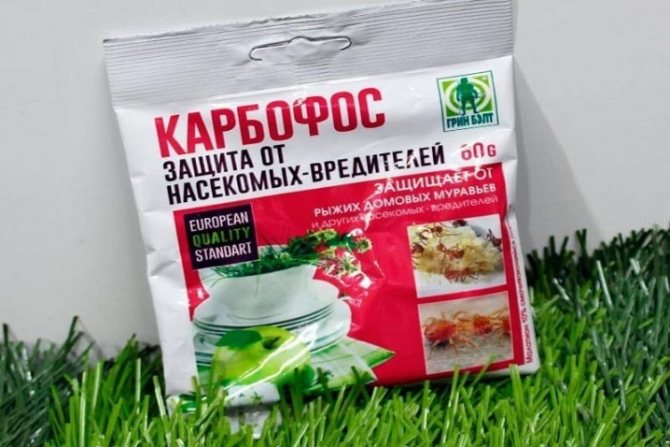

Planting viburnum and leaving with a photo
The plant needs well-lit and semi-shaded places. Viburnum is not a finicky plant, if you plant a viburnum bush in well-moistened soil, the plant will certainly delight you with excellent flowering and a bountiful harvest. Viburnum can be planted with the onset of spring and autumn. Optimally, the landing is considered to be in early April.
In order to plant a plant, first of all, you need to dig a sufficiently deep hole, up to about 50 cm. Further, a nutrient mixture is poured into the hole, which will feed the plant for 3 years. The mixture consists of humus, leaf and garden soil, peat and complex mineral fertilizers, which include potassium, phosphorus and nitrogen.
A young viburnum seedling must be placed in a hole on a loop mixture, while it is important that the root collar deepens by 5 cm. This stimulates the growth of new roots, which will strengthen the viburnum in the soil and help it quickly adapt.
After that, the seedling needs to be covered with earth and watered with warm water. In order to protect the root system, a mulch mixture must be poured around the seedling.
Viburnum leaf beetle Description
The beetle is large enough (up to 7 mm), the back is colored brown. Clutch of eggs (about 20 pieces), hides in young shoots of viburnum.
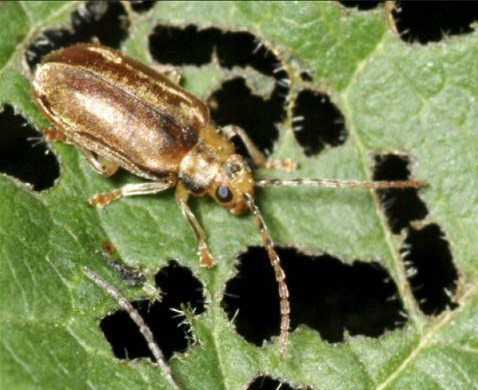

At the end of spring, larvae appear from yellowish eggs, which begin to feed on the delicate pulp of the leaves. Often their vital activity is so active and aggressive in relation to the plant that only one "skeleton" remains of the leaves.
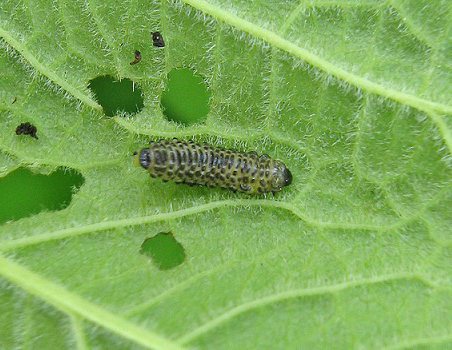

At the beginning of summer, the larvae of the leaf beetle pest ripen for further pupation, and hide underground to turn into young beetles there. Now, in a new guise, they again go to the viburnum, but this time not to eat the pulp of the leaves, but to gnaw holes in them.
The most favorable conditions for mass propagation of the leaf beetle are cold, damp and rainy weather. In this case, the number of pests can increase so much that the damage from them will be colossal: instead of leaves, only eaten cuttings and large veins remain on the viburnum.
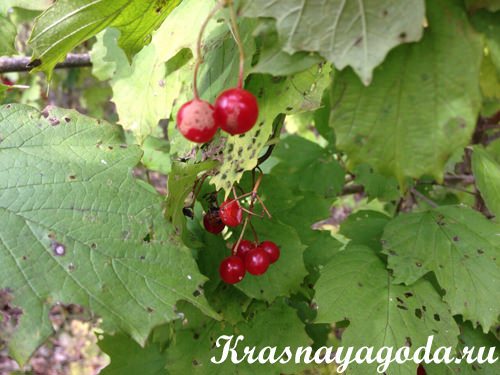

The beetle is dangerous because after it has dealt with the foliage, it moves to the inflorescences of berries, which threatens the complete death of the crop and the plant itself. In this case, the damaged bush stops growing and will not bloom for the next year. In the middle of summer, it is time for female leaf beetles to lay eggs, which they hide under the bark.
Viburnum pests and diseases, methods of cure
The main pests of viburnum include:
1. Viburnum leaf beetle
Beetle, light brown color, up to 6 mm in size. With the onset of August, the plant begins to lay eggs in the grooves of the shoots, in shocking quantities - up to 700 pieces. In winter, young shoots dry out, but the laid eggs overwinter calmly. In May, eggs ripen and larvae hatch from them, and immediately begin to destroy young shoots and leaves. In June, the larvae burrow into the soil to pupate. Already with the onset of July, beetles appear that eat the leaves.
Read also: Useful and harmful properties of black radish
How to deal with viburnum leaf beetle?
- It is imperative to cut off young shoots in the autumn and spring, and you also need to immediately remove the leaves on which there are larvae;
- In the spring, even before the leaves bloom, the bush must be processed: Fafanon, Karbofos, Akttelik, Aktara. And you also need to take Intavir twice with an interval of up to 10 days.
2. Viburnum aphid
The leaf-rolling aphid is black. The sizes reach only 7mm. From eggs that have successfully overwintered, larvae hatch in the spring. Aphids are able to actively reproduce and feed on plant juices. The foliage of the viburnum begins to curl, deform and dry out.
How to deal with viburnum aphids?
It is necessary to complete the first processing even before the buds bloom, this will significantly reduce the number of eggs that have been able to overwinter. Preparations must be alternated: Fufanon with Karbofos. It is also possible to use biological devices: Iskra, Intavira, Akarin.
3. Cap moth
The method of getting rid is no different from viburnum aphids. It is necessary to prune young shoots with the onset of spring and spray the bush with Karbofos, a solution of 90g / 10l of water.
4. Comma shield
To get rid of this pest, it is necessary to do preventive pruning in autumn and spring, sprays the viburnum with a solution of Karbofos, with the onset of August, sprinkle with Fufanon and Iskra.
Viburnum gall midge
Viburnum gall midge damages plant flowers. Its larvae are white; they hibernate in spider cocoons in the upper layers of the soil. Adult gall midges appear when the buds are exposed. Females of the viburnum gall midge lay eggs inside the bud, and the larvae also develop here. Damaged buds acquire an ugly shape, greatly enlarge, swell, turn red, their corolla thickens, the stamens and pistil remain underdeveloped. As a result, the flowers do not open. The pest develops one generation.
Control measures. Late autumn and early spring soil digging. Spraying before and after flowering with 10% Karbofos, Iskra or other approved insecticides.
Viburnum gall midge
What are the methods of dealing with diseases?
From spotting and powdery mildew, there is such prevention:
- Throughout the season, the plant must be pollinated with an infusion of tobacco, garlic and onions. This composition will not affect the taste and quality of the berries;
- It is imperative to perform sanitary pruning, and the removal of plant residues and thinning of the bushes is also considered mandatory. This will significantly help stop the development of the infection, as well as destroy its foci.
From putrid lesions of the leaves, before budding, and also after flowering, viburnum must be treated with Bordeaux composition. Such drugs are also considered effective - Hom, Abiga-Peak.
Honeysuckle prickly sawfly
The sawfly damages the decorative and edible honeysuckle and viburnum. The larva of the pest has an olive-colored body and two transverse rows of white thorns, with a dark red back or mesh pattern, light-gray sides and a yellow head. The larvae hibernate in the upper layer of the earth. Pupation occurs in the spring. Adult pests appear during the opening of leaves, on which females lay eggs. The hatched larvae eat the leaves. They can overeat until they are completely naked.
Control measures
To combat the sawfly, autumn digging of the earth is effective. Then you need to spray the bushes before flowering and after it with 10% karbofos (100 g per bucket of water), as well as treat the plant with wormwood broth (750 g of dried herbs per bucket of water) or garlic, tobacco, onions (200 g of tobacco waste or dust, 200 g of ground onion or garlic and 200g of onion peel in a bucket of water).
Plant care includes several stages:
1. Watering the viburnum. The planted young seedling must be watered at nightfall, the soil must be soaked by about 40 cm. The adult plant must be watered during the growing season and during the harvest season.
2. Top dressing. With the onset of spring, the soil around the plant must be fertilized with 2 tablespoons of urea. Before the viburnum begins to bloom, the soil must be fertilized with 2 tablespoons of potassium sulfide or wood ash. In the summer, the viburnum must be fed with complex mineral fertilizers, you need 60 g. After 2 years, with the onset of autumn, the viburnum must be fertilized with rotted manure and combined phosphorus-potassium fertilizers. In drought, to achieve the effect, the fertilizer must be diluted with water.
3. Crown formation and pruning. For a year, the branches of the viburnum can grow by more than 40 cm. It is necessary to prune with the onset of spring, it is necessary to form a crown, remove unnecessary or painful branches. For fully matured, not young plants, it is recommended to perform anti-aging pruning, but this procedure must be done when the bush has reached the age of 6 years. For this it is necessary to cut off the obsolete shoots to the root part. But you need to leave about 15 branches. If the bush is very weak, gives few fruits, it must be cut at the root up to 20 cm, which stimulates it to grow actively.
Testimonials
Pour wood ash under the bush with a thick layer, dig up the ground. This should be done in late autumn or early spring, as soon as the land allows it to be done. Ash poisons the sap of the plant. Leaves become tasteless and life-threatening for aphids. Such a remedy will not hurt Kalina. Additionally spray every week during the growing season with soapy water and baking soda.
We have several effective recipes for processing viburnum. Spray the bush with whey. Aphids do not tolerate sour taste, gradually disappears. We also spray with Coca-Cola. Why does it work, I did not understand, but it helps exactly. The most effective remedy that helps with a strong aphid infection of the tree is a mixture of ash, black pepper, twisted garlic, onions, and soap. The ratio of ingredients does not play a special role. Two treatments with an interval of 3 days are enough to completely destroy aphids.
We process the viburnum with tincture of tobacco, wormwood, add ash, soap. In early spring, we water the bush at the very roots with hot water. Aphids do not bother, the harvest is good.
Before choosing an effective remedy, it is necessary to assess the degree of damage to the viburnum, the time of the growing season, safety for yourself and the plant. In parallel, destroy ants, since it is they who are the main distributors of black aphids on the land plot of the garden, vegetable garden.
Green lobed moth
The greenish lobed moth is capable of damaging viburnum, buckthorn lilacs and other shrubs. This pest is a yellow-green caterpillar with two pairs of abdominal legs and a red-brown line along the back of the same color with dots and spots. It does harm only to flowers by gnawing flower ovaries.
Control measures
In order to combat this pest, viburnum should be sprayed with 10% karbofos before flowering and after it.
In general, take care of the viburnum from pests and it will delight you with its flowering and healthy berries every year.
You may also be interested in the articles: "Kalina ordinary, growing and care" and "Medvedka ordinary".
Chemicals
- Arrivo;
Arrivo - Fury;
Fury from aphids - Fufan (but how to use fufanon from weevil on strawberries is indicated here);
Fufanon from aphids - Karbaphos.
The action of systemic drugs is aimed at the fact that the components actively penetrate into the tissues of the tree, making its sap poisonous. Such funds should be used when processing tall trees, since it is not so easy to spray the top of the head. Such preparations are not afraid of rain, as they are quickly absorbed by the leaves. But the system tools have one drawback. You have to wait 2-3 weeks for a positive effect to be achieved.
- Fi-Toverm;
Fitoverm - Akarin;
Akarin - Agravertine KE;
- Aversectin.
In the development of these preparations, the waste products of the soil microorganism aversectin were used. You can also purchase products based on cypermethrin and permethrin - Iskra, Intavir. Their peculiarity is that they quickly decompose and do not lead to the development of addiction in insects. But they have a minus - if the drugs are stored incorrectly, they will lose their properties. But how to use a spark from a weevil on a strawberry, you can learn from this article.


It is necessary to fight aphids on viburnum with the help of pesticides in early spring. Many gardeners are confused about which drug is best. Experts recommend using systemic means of action in such a situation. Being absorbed into plant tissue, they negatively affect insects that feed on the sap of this culture.


Chemical preparations for the destruction of aphids
Before the buds appear, the viburnum bush can also be treated with Nitrafen infusion (200 g of the product per 1 liter of water). Do not forget that one of the main reasons for the spread of aphids are ants that feed on the secretions of the pest. Therefore, similar means are used when an ant nest is found in a personal plot.


